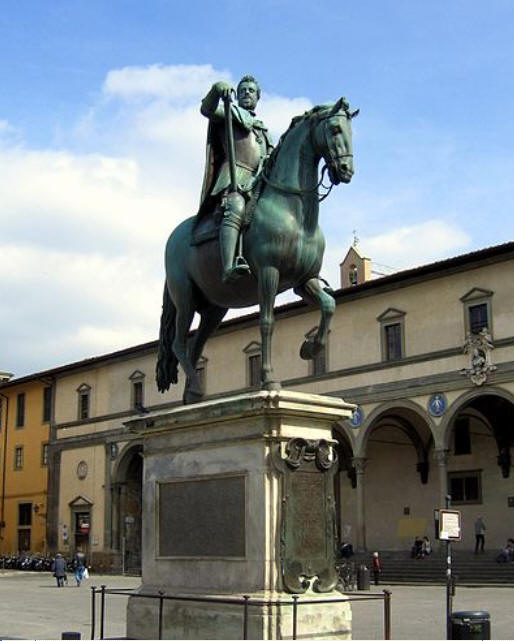

Cardinal Ferdinando 1 de Medici 1549-1609, Grand Duke of Tuscany 1587-1609. This statue is actually located in Firenze, and to symbolize Livorno we prefer it over the ghastly Quattro Mori statue commonly taken to be a symbol of Livorno. The statue is by Pietro Tacca 1577-1640, a follower of Giambologna, and who started his life's work in a Mannerist style but completed it in a Baroque style. Tacca also contributed to Quattro Mori statue in Livorno
The Grand Duke's laws of the 1590s promoting trade and welcoming Jewish merchants no doubt boosted his own revenues, but as a result Livorno became a major trading port (ref 52) linking trade in the Mediterranean and the East with Atlantic trade. Jewish merchants from all over the Mediterranean and elsewhere located there in force, and names occurring in our story - Lousada, Baruch, Lumbroso, Montefiore and Miranda - appear there. English ships were common - by one report over half the ships in Livorno were English. Many wealthy Sephardim of Livorno, from the late 1600s, registered their wills in London and Amsterdam (ref 64 pp 60-4). An illustration (from ref 64 p59) of the linking role Livorno played in the 1600s is given in the 1625 will of Abraham Baruch aka Diogo Nunes then of Venice. It tells us 'that three of his brothers were still living in Portugal as New Christians and one had left for the Indies; he had a sister married to a nephew of his in France and one married to a new Jew in Livorno, and his trade involved large amounts of sugar from Brazil, which he kept in the house of the Spanish and Portuguese consul in Venice'!
From the start, Livorno was a very timely transitional stay for Iberian New Christians. In the 1590s in Portugal, famine and persecution peaked in northern Portugal (ref 35 p100) and this prompted emigration to Spain. But Spain became increasingly hostile to Portuguese New Christians in the savage post-1643 reaction to d'Olivares' policies. Whilst Amsterdam and Hamburg were already Jewish havens, the new opportunities in Livorno beckoned so Livorno rapidly became a major Jewish haven, but further havens soon emerged in the form of London, Barbados, Surinam, Curacao and Jamaica (though it had been relatively safe for New Christians even under Spanish rule before the 1655 English takeover). Livorno was a source of Jews heading for the Caribbean under Dutch auspices in the decade after the fall of Dutch Brazil in 1654. Some details on these voyages can be found here. Many New Christian families sojourned in Livorno - Victor Perera (ref 59 p3) attributes Italian words in his mothers Ladino to the journey through Livorno and Ferrara of his Pereira family forebears on their journey over generations from Spain/Portugal via Salonika and Jerusalem to Guatemala.
Eventually, in the early-to-mid 1700s, the tide in Livorno's fortunes turned and its population started to decline after strong rises in the 1600s. A key factor was the shift in the rough diamond trade from India - for which a principal barter commodity was Mediterranean coral. As the focus of Indian diamond export shifted from Goa to Madras, and as South American rough diamonds came onto the market Livorno's key role diminished - and London became the centre of the rough diamond trade. Diamond cutting and polishing shifted from Antwerp to Amsterdam - cementing bonds between London and Amsterdam. The coral trade linked Livorno with Russia (ref 95) and many other places.
The Grand Duchy of Tuscany came under direct Habsburg rule in 1765 (ref 64 p76) but the favourable tax treatment for Sephardic Jews lasted until Napoleon.